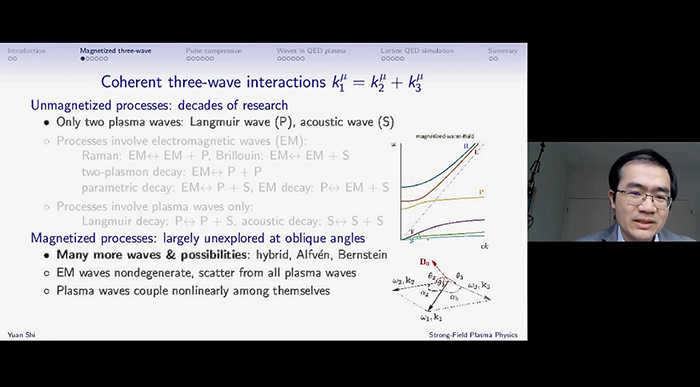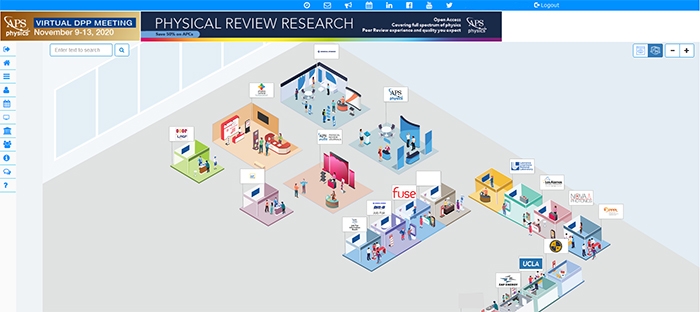NIF Experiments Among Highlights at Virtual APS Plasma Physics Conference
 LLNL’s Yuan Shi, winner of the 2020 Marshall N. Rosenbluth Outstanding Doctoral Thesis Award for his theoretical dissertation on three-wave coupling, is shown giving his presentation on “Plasma Physics in Strong-Field Regimes” at this year’s virtual APS Division of Plasma Physics meeting. Credit: Tammy Ma
LLNL’s Yuan Shi, winner of the 2020 Marshall N. Rosenbluth Outstanding Doctoral Thesis Award for his theoretical dissertation on three-wave coupling, is shown giving his presentation on “Plasma Physics in Strong-Field Regimes” at this year’s virtual APS Division of Plasma Physics meeting. Credit: Tammy Ma Scientific discoveries, educational opportunities, and wide-ranging events highlighted the recent 62nd American Physical Society-Division of Plasma Physics annual meeting, which attracted a record number of participants from around the world.
The virtual meeting, on Nov. 9-13, was run out of Memphis, Tennessee, the original site of the conference, and drew more than 150 physicists, engineers and students from LLNL. They were part of a record crowd of 2,214 registrants for presentations, poster sessions, and seminars on topics ranging from astrophysical plasmas to nanotechnology to fusion development.
Presentations from LLNL physicists highlighted NIF & Photon Science research, including experiments on NIF’s Advanced Radiographic Capability (ARC) laser system, progress in energy-coupling studies using advanced hohlraums, and achieving hot-spot energies with the largest high-density carbon implosions with the hybrid experimental-E design.
Among the speakers was Yuan Shi, a 2018 graduate of the Princeton Program in Plasma Physics and winner of the 2020 Marshall N. Rosenbluth Outstanding Doctoral Thesis Award for his theoretical dissertation on three-wave coupling. He is now a Lawrence Fellow at LLNL. Shi’s talk was titled, “Plasma Physics in Strong-Field Regimes.”
“The quality of the talks from LLNL folks was phenomenal,” said Tammy Ma, program element leader for High-Intensity Science. “It is a true testament that even during this crazy time, the LLNL team continues to make great progress in their scientific and technical work and manages to put out these polished presentations.”
Ma praised the APS-DPP leadership for its “amazing job pivoting so quickly to host APS in this online format.” She said the lack of normal social contact was a drawback, and noted some technical issues, but said “everyone was super understanding and worked through the issues.”
 The virtual APS conference allowed attendees to visit virtual booths.
The virtual APS conference allowed attendees to visit virtual booths. Kelli Humbird presented on a machine-learning technique called “transfer learning,” which combines simulation knowledge and previous experimental data into a model that is more predictive of future inertial confinement fusion (ICF) experiments at NIF than simulations alone.
“In short, our models of ICF experiments are good, but not perfect across the broad range of design space our NIF experiments span,” Humbird said. “So to accurately predict the outcome of future NIF experiments, we need to adjust our model based on what we’ve observed in previous experiments. My talk explored transfer learning as a way to ‘correct’ simulation predictions by essentially learning the difference between what our simulations predict and what we actually observe.”
The result is a model that predicts the outcome of some recent experiments with significantly higher accuracy than the simulations alone.
“One of the big benefits of this model is that it can be updated every time we carry out an experiment, getting smarter and more accurate as we acquire more data and explore more of the NIF design space,” Humbird said.
Humbird said her favorite part of the virtual format was the question-and-answer session. In person, she has only five minutes to answer just a few questions from the audience. But with the virtual chat, she was able to spend 20 minutes answering each question thoroughly.
“It was a nice way to facilitate dialogue between speakers and the audience,” she said.
The other NIF-related invited talks from LLNL staff included:
- Peter Amendt: “Progress in High Capsule-Energy-Coupling Studies on the NIF Using Advanced Hohlraums.”
- Daniel Casey: “The Impact of Low-Mode Areal-Density Non-Uniformities in Indirect-Drive Implosions at the National Ignition Facility.”
- Tilo Döppner: “X-ray Scattering Measurements from Near-Degenerate Plasmas at Gbar Pressure at the National Ignition Facility.”
- Mikhail Dorf: “Continuum Gyrokinetic Simulations of Edge Plasmas in Single-Null Geometries.”
- William Farmer: “Validation of Heat Transport Modeling Using Directly Driven Beryllium and Gold Spheres.”
- Gareth Hall: “Measurement of Mix at the Fuel-Ablator Interface in Indirectly-Driven Capsule Implosions on the NIF.”
- Shaun Kerr: “Development of Bright MeV X-ray Sources with Compound Parabolic Concentrator Targets on Petawatt Class Lasers.”
- Andrea Kritcher: “Achieving Record Hot Spot Energies with the Largest HDC Implosions on NIF in HYBRID-E.”
- Michael MacDonald: “Developing X-ray Fluorescence Spectroscopy as a Temperature Diagnostic for High-Energy-Density Physics Experiments.”
- James Mitrani: “Evidence for Thermonuclear Neutron Production From a Sheared-Flow Stabilized (SFS) Z-Pinch.”
- Arthur Pak: “Impact of Localized Radiative Loss in Inertial Confinement Fusion Implosions.”
- Hye-Sook Park: “Studying Materials Under Extreme States of High-Energy Density Compression.”
- Genia Vogman: “Large Gyroradius Effects on Gradient-Driven Plasma Instabilities.”
- Jackson Williams, LLNL: “Efficient Electron Acceleration and Pair Production Using the NIF-ARC Laser.”
—Jon Kawamoto
Follow us on Twitter: @lasers_llnl



